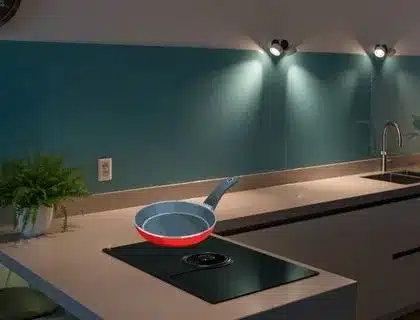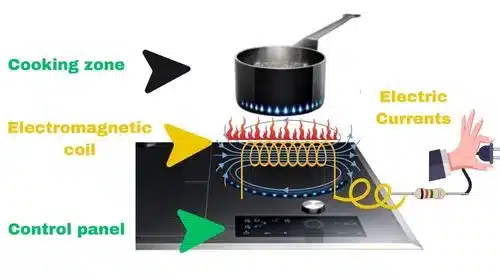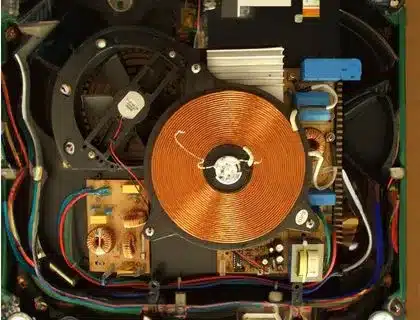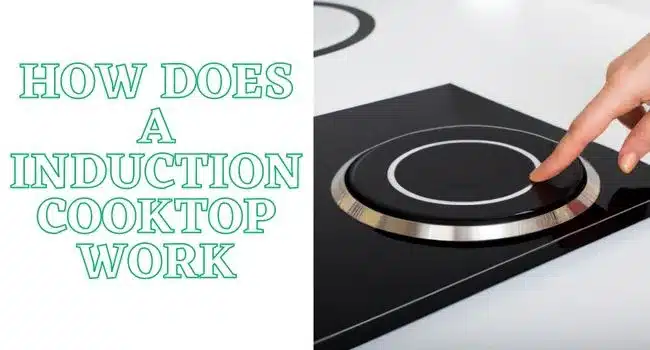Induction cooking is a popular method that has been gaining popularity recently. Instead of using gas or electric heat for cooking food, induction cooktops use electromagnetic fields to heat up the cookware directly, allowing for faster and more precise cooking. There are many advantages to using an induction cooktop over traditional gas or electric cooktops, including energy efficiency, safety, and precision temperature control.
Table of Contents
How Does A Induction Cooktop Work
In this blog post, we’ll look at how induction cooktops work, the benefits of using one, and what you need to know before purchasing an induction cooktop. Whether you’re a seasoned cook or a beginner in the kitchen, understanding how induction cooking works can help you choose the best cooktop for your needs and take your cooking to the next level.
What is an Induction Cooktop?
An induction cooktop is an electric stove that uses electromagnetic fields to generate heat instead of gas or electric heating elements. The basic components of an induction cooktop include a coil of copper wire underneath the cooking surface, an electronic control unit, and a glass or ceramic surface that acts as the cooking surface.
There are two main types of induction cooktops: built-in and portable.
- Built-in cooktops are installed into a kitchen countertop and are typically available in 30-inch and 36-inch sizes.
- Smaller and more portable cooktops are a good choice for limited kitchen space or outdoor cooking.

Some popular brands of induction cooktops include Empava, GE, Samsung, Bosch, and KitchenAid.
How Does An Induction Hob Work
Instead of heating the cooking surface, induction cooking heats the cookware directly. When you turn on an it, an electric current flows through the coil of copper wire beneath the cooking surface, creating an electromagnetic field. When you place a compatible pot or pan on the cooking surface, the magnetic field induces an electrical current in the cookware, which creates heat.
Due to the fact that the heat is generated directly in the cookware, induction cooking is very energy efficient. Moreover, they ensure safety by eliminating the risk of an open flame or exposed heating element.

In this diagram, the cooking zone is where the ferromagnetic cookware is placed for cooking. The electromagnetic coil is located beneath the cooking zone and generates an alternating electromagnetic field when an electric current is passed through it.
The ferromagnetic cookware responds to this electromagnetic field and generates heat through the resistance created by the eddy currents induced in the cookware. Cooking settings and temperature can be adjusted via the control panel.
How Does An Induction Stove Work:
| Component | Description |
|---|---|
| Cooking zone | The area on the cooktop surface where the cookware is placed for cooking. |
| Electromagnetic coil | A coil of copper wire located beneath the cooking zone generates an alternating electromagnetic field when an electric current is passed through it. |
| Ferromagnetic cookware | Cookware made of iron, steel, or other magnetic materials that can be magnetized and respond to the electromagnetic field generated by the coil. |
| Eddy currents | Electrical currents are induced in the ferromagnetic cookware by the alternating electromagnetic field. |
| Resistance | The eddy currents create resistance in the cookware, generating heat to cook the food. |
| Control panel |
Several settings can be adjusted on the cooktop surface, including the temperature. |
This table provides a brief overview of the main components involved in how an induction cooktop works. An alternating electromagnetic field is generated by passing an electric current through an electromagnetic coil, which induces eddy currents in ferromagnetic cookware placed on the cooking zone.
These eddy currents create resistance, generating heat to cook the food. The control panel allows the user to adjust the temperature and other cooking settings for precise cooking control.
An inside view of the cooktop is shown as under:

Materials Used in Induction Cooktops
Induction cooktops are typically made with a ceramic or glass surface and a coil of copper wire underneath. The surface is designed to be easy to clean and heat-resistant, while the copper wire coil is responsible for generating the electromagnetic field that heats up the cookware.
Some induction cooktops include additional features like touch controls, timers, and safety features like automatic shutoff.
Types of Induction Cooktops
There are several types of induction-cooktops available on the market, including:
Single element: These cooktops have a single heating element and are typically used as portable cooktops or as an additional burner for large meals.
Multi-element: Multi-element cooktops have multiple heating elements built into a countertop. They’re available in various sizes, from compact 24-inch models to larger 36-inch models.
Induction range: An induction range combines an induction cooktop with an oven, creating a complete cooking appliance. Induction ranges are available in slide-in and freestanding models.
Benefits and what you need to know about Induction Cooking:
Induction cooktops offer numerous advantages over gas or electric cooktops, some of which are highlighted below:
Rapid heating and greater efficiency:
It can heat up in seconds and cook food faster than its gas or electric counterparts, resulting in significant energy savings and reduced cooking times.
Enhanced safety features:
Since these cooktops don’t rely on an open flame or exposed heating element, they are much safer, making them a wise choice for homes with children or elderly individuals.
Precise temperature control:
They are ideal when cooking tasks such as melting chocolate or making custards require precise temperature control. An induction cooktop can easily achieve and maintain the desired temperature, ensuring perfect results every time.
Easy cleaning and maintenance:
Because there’s no exposed heating element or flame, spills and splatters are less likely to burn onto the cooktop surface, making cleanup easier.
Induction Cookware
To use an induction cooktop, you’ll need compatible cookware. Induction cookware must have a magnetic bottom to work with the magnetic field created by the cooktop.
Common materials used in induction cookware include stainless steel, cast iron, and enameled cast iron. Some popular induction cookware brands include All-Clad, Calphalon, and Le Creuset.
Installation and Maintenance
Installing an induction cooktop is similar to installing a traditional gas cooktop. You’ll need to make sure you have the correct electrical setup and that the cooktop is properly installed into your countertop.
Maintenance is straightforward. You’ll need to clean the cooktop regularly to prevent the buildup of food and spills, and you may need to replace the cooktop if it becomes damaged.
FAQs:
Do you need special pans for an induction cooktop?
Yes, you need special pans for an induction cooktop. Induction cooking utilizes an electromagnetic field to heat up the cookware directly. The cookware must be crafted from a magnetic material to function with the induction cooktop. Some common materials utilized in induction cookware are:
- Stainless Steel: It’s a frequently used material for induction cookware because of its robustness and effortless maintenance.
- Cast iron: Cast iron cookware is also compatible with induction-cooktops known for retaining heat and creating a good sear on meats.
- Enameled cast iron: Enameled cast iron cookware is coated with a layer of enamel, making cleaning easier and preventing rusting.
- Carbon steel: Carbon steel cookware is similar to cast iron but is lighter and heats up more quickly.
A quick and easy test can be conducted to determine if your current cookware is suitable for an induction cooktop. Place a magnet on the bottom of the pan. If the magnet adheres to the pan, it can be used on an induction cooktop. Conversely, if the magnet doesn’t stick, it implies that the pan is not suitable for use with the induction cooktop.
Do induction cooktops use a lot of electricity?
Induction cooktops are generally more energy-efficient than gas or electric cooktops. They use electricity to create an electromagnetic field that directly heats up the cookware without heating up the surrounding air.
Unlike traditional electric cooktops, induction cooktops can be up to 50% more energy-efficient. This is because traditional electric cooktops heat up the coils underneath the surface, transferring heat to the cookware. This process can be less efficient because some heat is lost to the air around the cookware.
However, it’s important to note that the amount of electricity used by an induction cooktop can vary depending on a few factors, such as the power level and the size of the cookware used. Generally, higher power levels and larger cookware will require more electricity.
Even at the highest power levels, induction cooktops are still more energy-efficient than electric ones.
And because they heat up more quickly and precisely, they can also reduce cooking times and save energy in that way as well.
What happens if you use the wrong pan on the induction hob?
If you use the wrong pan on an induction hob, it may not work efficiently. Induction hobs require cookware made from a magnetic material to work properly.
If you try to use a non-magnetic pan, such as an aluminium or copper pan, on an induction hob, the hob won’t detect the pan or generate the electromagnetic field needed to heat it up.
Induction hobs require specific types of cookware made from magnetic materials to work correctly. If you attempt to cook on an induction hob with an incompatible pan, the hob will not generate the necessary electromagnetic field to heat up the cookware. As a result, the burner will not turn on, and the pan will remain cold.
While this may initially seem like a minor inconvenience, using the wrong pan on an induction hob can actually have some negative consequences. For one, it can reduce the efficiency of your cooking and lead to unevenly cooked food. Additionally, attempting to use non-magnetic pans on an induction hob can cause damage to both the hob and the cookware, as the hob may generate excessive heat or become damaged due to the pan not sitting correctly on the surface, while the pan may overheat or warp.
Therefore, it’s always important to use induction-compatible cookware on an induction hob to ensure proper and efficient cooking and to prevent any potential damage to your hob or pans. If you need clarification on whether your cookware is compatible with your induction hob, it’s a good idea to perform a simple magnet test to check for compatibility.
Sometimes, you can use a non-magnetic pan on an induction hob with a magnetic base or a special induction-compatible disk on the bottom. However, even in these cases, the cooking efficiency may be reduced because the pan could better fit the hob.
Can I use stainless steel for induction?
Yes, you can use stainless steel on an induction hob, as long as the stainless steel is made with a magnetic material. Stainless steel is one of the most commonly used materials for induction cookware because it is durable, easy to clean, and conducts heat well.
However, not all stainless steel cookware is induction-compatible. Stainless steel must contain iron or be layered with magnetic material to be compatible with induction.
It won’t work on an induction hob if your stainless steel cookware is not magnetic.
If you want new induction-compatible stainless steel cookware, look for brands that advertise their compatibility with induction. It will ensure that you purchase cookware that works with your induction hob.
Conclusion
Induction cooktops are great for fast, efficient, and safe cooking. With their precise temperature control and easy cleanup, induction cooktops are a favourite among home cooks and professional chefs. By understanding how induction cooking works and what you need to look for when purchasing an induction cooktop, you can choose the best one for your needs and take your cooking to the next level.
